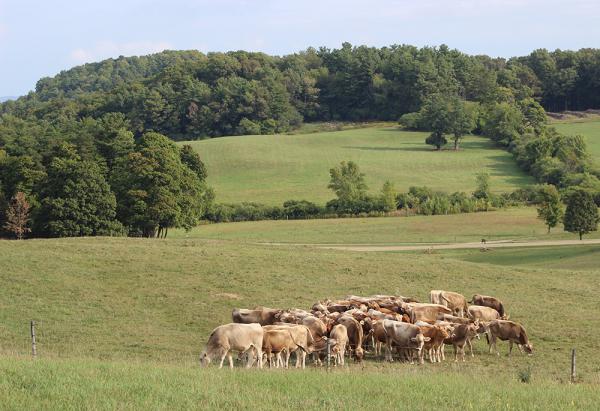Wow, My wife and I visited Shelburne farms in early June and enjoyed the cheese tasting, and getting the farm tour seeing the browns get milked. It was so lush and green at that time. We live north of Binghamton in Chenango county with a robust dairy farming community. Amazing how a few hundred miles away it was hotter and drier. One could say we had to much rain this year and south of us in Pennsylvania they suffered severe flooding. My brother lives just miles away from Shelburne Museum and as we talked over the summer he kept mentioning how hot and dry it was. Best of luck with keeping the wonderful swiss browns happy and churning out the milk that makes your world class chedder cheese.
Dry Summer at the Dairy
This summer was hot in the Champlain Valley. And dry.
No one knows this better than our Farm Manager Sam Dixon and our Brown Swiss cows.
The season started out well, with green pastures to graze and a good first cut of silage in early June. (Dairy 101: some fields are grazed as pasture; separate fields are mowed 2-3 times a year for hay or silage.)
But conditions soon went south.
In July, we didn’t even take a second cut on many fields. In mid-July, milk production crashed. The cows made 5,300 lbs of milk on July 19; four days later, they made 4,600 lbs -- a 13% drop in production.
“There was nothing for the cows to eat because there was nothing out there. It was so drought-stressed. The plants just withered.” Sam explains.
On July 23rd, we pulled our cows into the barn and started feeding them full time inside. (The cows still got out for an hour or so a day for exercise and fresh air, and they stayed perfectly healthy.) For the rest of July and most of August, the cows were fed silage we had made last year. Fortunately, we had quite a bit left over.
“I’ve been glued to the weather radar all summer,” Sam admits. “But the storms have been so spotty and intense -- many have just missed us altogether. It’s been spotty all across Vermont.”
“This is what climate change looks like” he goes on to say. “It’s these swings.”
“We’re lucky because we have a big farm. And we have a resilient system in that it’s a perennial grass farm. We’re not dependent on an annual crop like corn. We make extra feed when we can and keep it for next year -- kind of like insurance.”
Now, well into September, the cows are making about 5,800 lbs of milk a day, which is normal. But they still spend limited time on pasture. Since August 24th, they’ve been out grazing about 2 hours a day. Usually they’d be out the entire day, but two hours of grazing is all the pastures can support.
As for the fields we cut for stored feed, production is down nearly half overall.
“We need inches of rain.” says Sam, “We just haven’t had enough rain throughout the season to keep things going. On the bright side, the feed we have been able to harvest is really good -- really high quality."
What has this all meant for cheesemaking?
While the daily level of milk in the vat has held fairly steady, yields have been inconsistent and have dipped overall. That means the same amount of milk makes less cheese. Our typical yield is 10.7-11% (~10 lbs of milk yields 1 lb of cheese), but this summer that figure fell below 10% for several weeks. “This obviously means a longer cheesemaking season to reach our production goal for the year,” says Andi Wandt, our head cheesemaker.
In addition, it's been tough to maintain our targets for moisture level in the cheese. Down the road, this may mean some of this “summer cheddar” will be processed at six months or a year, not aged out two or three years.
Adjusting for all these variables has kept our cheesemakers -- and Sam -- on their toes.
Welcome to the new normal.


